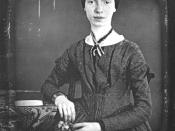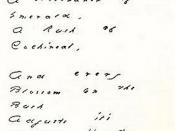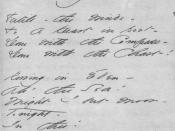A Dreamy Death
In her poem "712" Dickinson describes the interactions between a person and death. Her poem describes how the speaker is escorted by Death in its carriage. Death carries the speaker slowly and peacefully through time. It is ironic that Dickinson writes of Death's civility and politeness during a time that is mostly associated with confusion and sadness. The poem has a certain calm and tranquil feeling that makes the reader think of death in a different way than one usually would. Death is usually linked with thoughts of violence and rage not with a tranquil ride in a carriage. At the end of this poem, the speaker finishes her expedition realizing that she has died many years ago. Dickinson's main point in this poem is the inevitability of death and how we do not control our fate although we think we might.
With careful attention to style, Emily Dickinson creates a conflicting relationship between reality and the speaker's thoughts.
Her tone, imagery, and diction change in order to stress how one is seduced by death. In the beginning, Dickinson uses a joyous tone, controlling diction, and "civil" imagery in order to create a sense that death is peaceful. She does this in order to emphasize how the speaker cannot realize the consequences of her death. Although she may literally be taken by death, figuratively she remains oblivious to the meaning of death. In the end, through a change in imagery, tone, and rhythm, Dickinson emphasizes how the speaker is finally able to realize the world she knew is gone forever.
Although in the first line "Because I could not stop for Death" the poet gives us a hint of the speaker's disappearance in the world, the speaker thinks that she is still alive. To further emphasize how...


